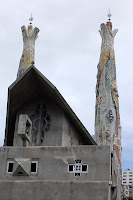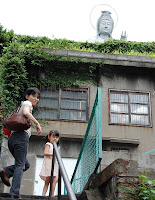
Our first destination was at the site of the twenty-six catholic martyrs who were crucified on a hill in Nagasaki 410 years ago after Toyotomi Hideyoshi, the ruler of Japan, outlawed Christianity and closed Japan to the outside world.
 When Japan began to open up again in the middle of the 19th century the ban on Christianity was lifted. It transpired that for the intervening three centuries a form of Christianity had been secretly preserved by communities of “hidden Christians” without priests or books.
When Japan began to open up again in the middle of the 19th century the ban on Christianity was lifted. It transpired that for the intervening three centuries a form of Christianity had been secretly preserved by communities of “hidden Christians” without priests or books.
We were to encounter evidence of that Christian heritage at various points during our holiday in Nagasaki prefecture, including at our fourth stop on today’s busy itinerary.
Just over the road from the memorial site is the Church of the Twenty Six Japanese Martyrs is notable for its concrete structure and pair of outlandish towers.
 A few minutes walk from the martyrs hill you come to some steps that lead up to our second destination, a temple called Fukusai-ji. The temple building is designed to resemble a huge turtle. On the back of the turtle there is an 18m-tall statue of Kannon-sama, Goddess of Mercy. You can see her peeping over the roof of the house at the top of the steps that H&E had climbed ahead of me on our stroll to the temple.
A few minutes walk from the martyrs hill you come to some steps that lead up to our second destination, a temple called Fukusai-ji. The temple building is designed to resemble a huge turtle. On the back of the turtle there is an 18m-tall statue of Kannon-sama, Goddess of Mercy. You can see her peeping over the roof of the house at the top of the steps that H&E had climbed ahead of me on our stroll to the temple.
The original temple was built in 1628 and destroyed by the A-bomb in 1945. It was rebuilt in 1979. Inside you will find the longest example of Foucault’s pendulum in Japan, and the third longest in the world. Foucault’s pendulum was made famous by Umberto Eco’s novel, Il Pendolo di Foucault. I bought the first Italian edition while living in Imola in 1988-89. Back in England in the summer of ’89 I thought it prudent to purchase “The Complete Guide to Foucault’s Pendulum” and took both books, along with the first Folio Society edition of Gibbon’s Decline and Fall of the Roman Empire with me when I moved to Rome that autumn. I read Gibbon, but Il Pendolo di Foucault and its English language guide langished unread on my book shelf and currently lie neglected in a box in mother’s attic; reading Il Pendolo di Foucault in Italian has become one of my “back burner projects”! Perhaps now that I have seen the eponymous device in action I might perhaps make a point of reading the book.
Mind you, I didn’t think we would be able to see the pendulum in action as the wire was motionless when we first saw it inside the temple. The wire is suspended from the top of the inside of the hollow Kannon statue down through the main temple building and into the basement, where the bob swings over a compass plate. We found the basement steps and went down but the door was locked, so that seemed to be that. However, when we came back up we were greeted by the woman who runs the temple.
“Herro! Key! You take!”
So back down we went with the lady right behind us. She promptly took the key back off me and opened up the basement, jabbering away all the time in a mixture of Japanese and Japlish-inspired pidgin English which was all part of a practised patter. She took a hook off the wall and used it to set the pendulum in motion.
Fixed to the compass plate by two metal arms that extend from the cente there is a metal contraption that looks like a metal comb which has been bent into a quarter circle, with its teeth pointing upwards. The “comb” swivels round so that you can line it up with the pendulum swing. The rotation of the earth gradually causes the axis of the pendulum swing to shift and the needle on the bottom of the bog eventually strikes the first tooth of the comb, knocking it over with a metallic “tock” – for the teeth are attached to the base of the comb by hinges. Gradually the pendulum shifts around and knocks each of the teeth down one by one.
That, at least, is the idea. However, when the pendulum appeared somewhat tardy in getting around to knocking over the first pin our guide said that perhaps she had not set it up properly because of her poor eyesite brought on by her advancing years (or “rougan” as the Japanese call it). She then gave the pin a nudge with her finger, knocking it over before the pendulum had got to it; that meant that there would be an even greater interval before the pendulum could shift far enough to knock the second pin down… We never did see the pendulum knock a pin down because we were ushered out of the basement and back upstairs for a guided tour of the temple. We had no choice in this matter.
“Hey!-You!-Look here!… Chinese furniture! All Chinese furniture… You think only decoration… No!” We were now standing in front of an elaborate Chinese furnishing of doubtful function and antiquity. Suddenly the old girl pulled a large decorative knob and opened a “secret draw”
“Hey!-Open door! Here Japanese soldier thousands dead ashes!”
“Open door! Here atom bomb dead ashes!”
We were force-marched outside and had to bash the peace bell with a log suspended before it on a couple of chains – but we couldn’t bash it any-old-how; the bashing thereof was accompanied by strict enjoinders as to where to place our feet and what posture to adopt. Next we had to splash some water over a statue and then inspect the carp pool. The old bird gave Little E some fish pellets to throw at the fish, and headed off with another couple of tourists to demonstrate the debilitating effect of “rougan” on the smooth running of Foucault’s pendulum.
We moved on to our third destination, Glover Garden, on Minamiyamate hill and offering a fine view of Nagasaki harbor. Our arrival at the former Mitsubishi second dock house presented Little E with a second chance to feed carp in a single morning!
Glover was a British trader, a sort of 19th century merchant adventurer who set up shop in Nagasaki in 1859, founded what was to become Mitsubishi, helped to establish Kirin beer brewery, introduced steam trains and mechanized coal mines to Japan and ran guns for the enemies of the Tokugawa shogunate. He commissioned warships for the new Meiji government, but had gone bankrupt by the time it came to power in 1868. However, he was awarded a consolation prize, that of being the first foreign devil to receive Japan’s Order of the Rising Sun. It must have been a fine time to have come to Japan; a combination of immense potential for business development at a time when both people and countryside were unspoilt by the effects of… er, full development of immense business potential…
Just down the road from Glover Garden was our fourth destination, Oura Church, the oldest church in Japan and the only western-style building in Japan to be designated a “national treasure”. The facade of the church faces in the direction of the hill on which the twenty-six martyrs were crucified. It was to the priest of this Oura Church that the “hidden Christians” made themselves known in 1865. Many of the hidden Christians returned to the Roman fold, but others chose to keep alive the traditions, or corruptions, that had grown up in the intervening centuries during which time the faithful had handed down the faith by word of mouth without books or priests.
Once the missals had been destroyed both words and dogmas began to decline from their original purity, and, according to Miyazaki Kentaro, “although the faith followed by the underground Christians had the outward appearances of Christianity, the vital content and spirit of the religion evolved into something entirely different.”
We moved on to our fifth destination, “Spectacles Bridge”, so called because the double arches of the bridge and their reflection in the river are said to look like a pair of spectacles. Didn’t look much like it to me, probably because the water level was too low. Spectacles Bridge.
David Hurley
japanese-mahjong.com
japanese-games-shop.com

I definitely did get to the temple with the Kannon statue and just had no idea there was a Foucault’s pendulum there.
And as for spectacle’s bridge one of the times I was there it was exactly like it was supposed to be and I think the other time it was only so-so.